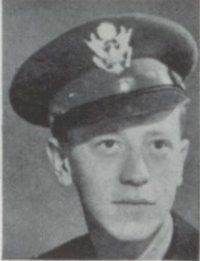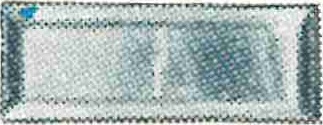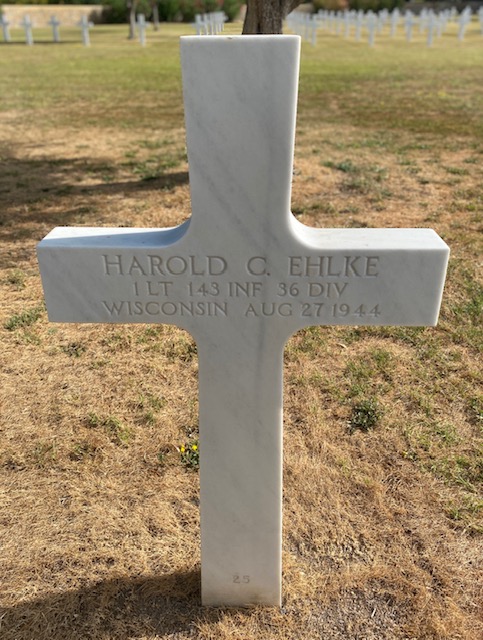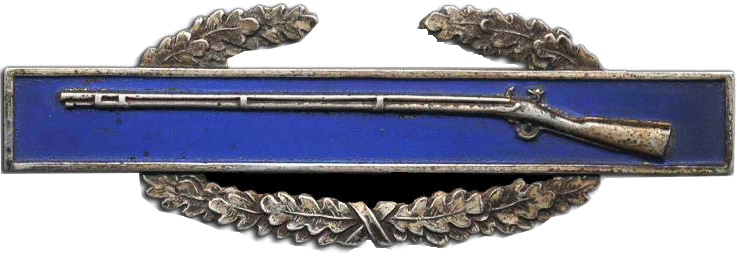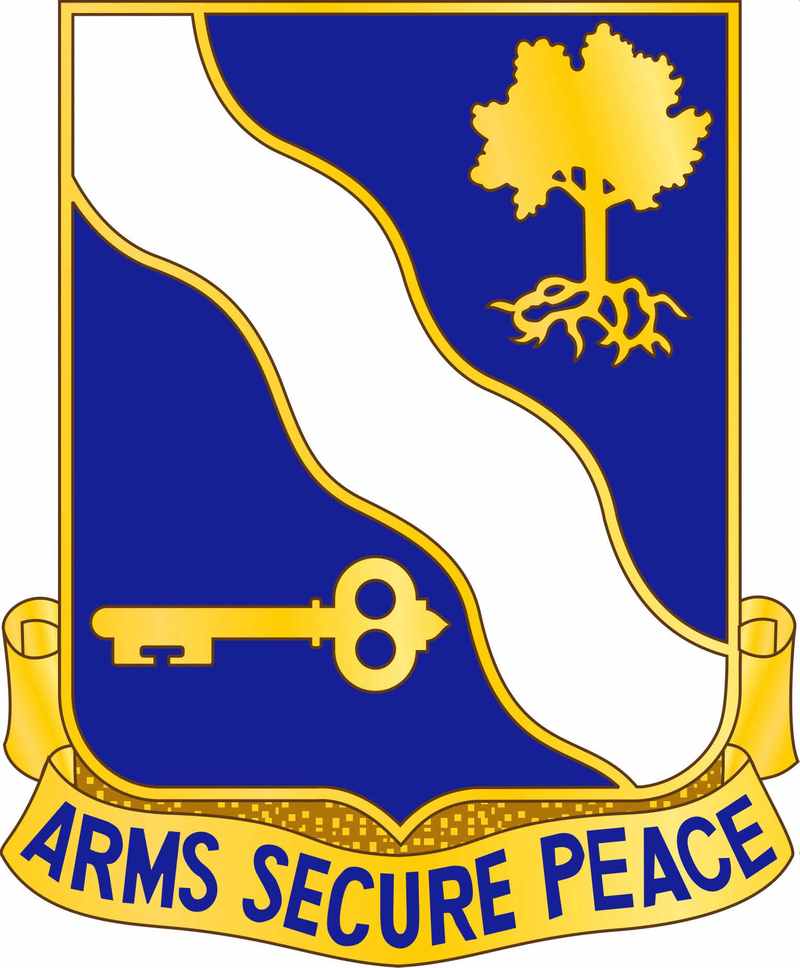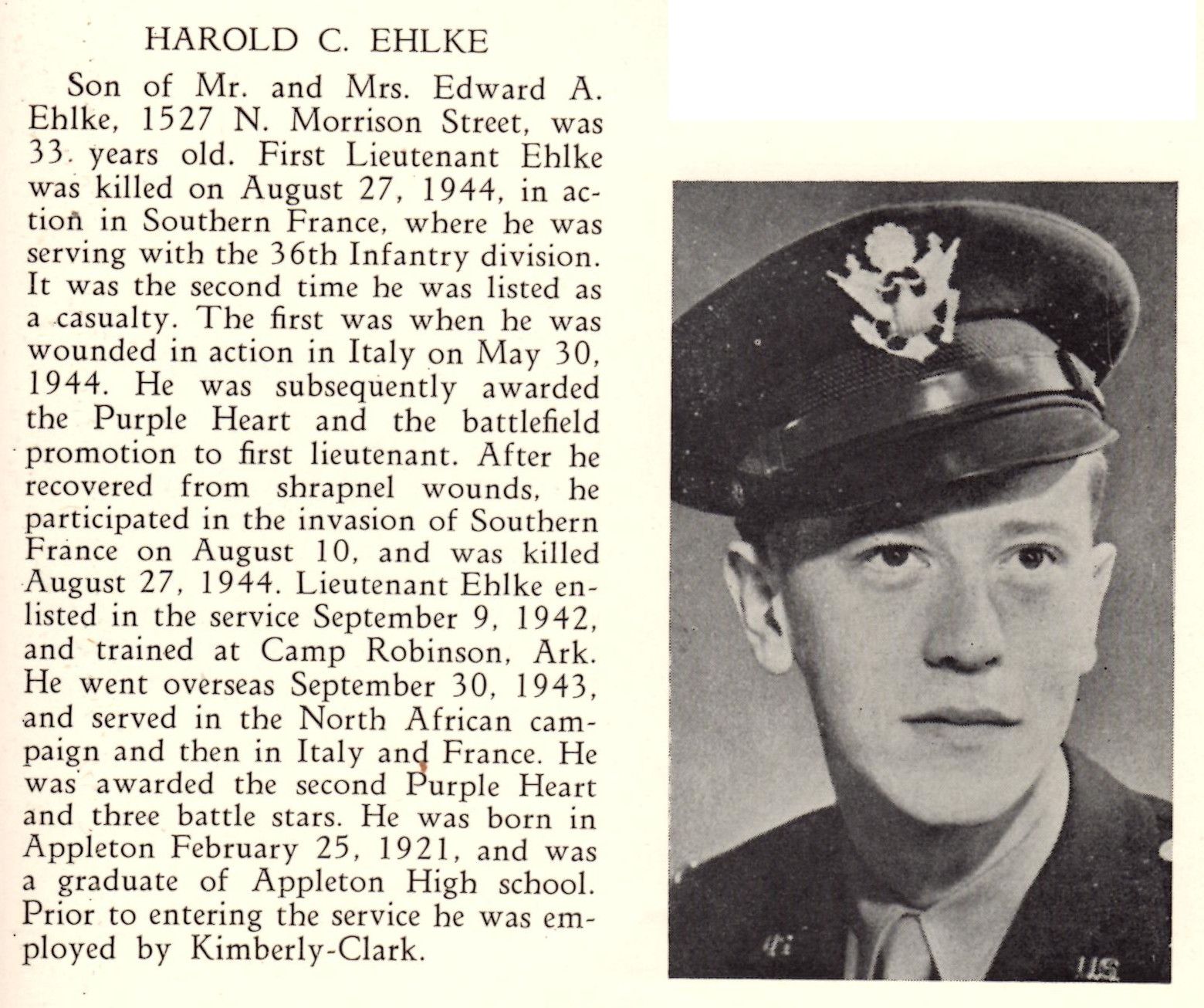|
Harold C. EHLKE
| ||||||||||||||||||||||||||
|---|---|---|---|---|---|---|---|---|---|---|---|---|---|---|---|---|---|---|---|---|---|---|---|---|---|---|
|
Source : Sandoftime
| ||||||||||||||||||||||||||
| NUMERO DE SERVICE | O-1313583 (16095905) | |||||||||||||||||||||||||
| AGE | 23 ans | |||||||||||||||||||||||||
| DATE DE NAISSANCE | 25 février 1921 | |||||||||||||||||||||||||
| ÉTAT D’ENRÔLEMENT | WISCONSIN | |||||||||||||||||||||||||
| FAMILLE |
Concubine : Louise KNAACK Parents : Mr. & Mrs. Edward EHLKE Frères : Earl & Ralph Soeur : Marion | |||||||||||||||||||||||||
| GRADE |
| |||||||||||||||||||||||||
| FONCTION | Chef de section | |||||||||||||||||||||||||
| PROFESSION AVANT INCORPORATION | Employé chez Kimberly-Clark |  | ||||||||||||||||||||||||
| DATE D'INCORPORATION | 11 octobre 1942 Milwaukee WISCONSIN | |||||||||||||||||||||||||
| COMPANY | Company L | |||||||||||||||||||||||||
| REGIMENT | 143rd Infantry Regiment | |||||||||||||||||||||||||
| GROUP | 36th Infantry Division | |||||||||||||||||||||||||
| ARMY | 7th US Army | |||||||||||||||||||||||||
| DATE DU DECES | 27 août 1944 |
Source : Victor DANIEL | ||||||||||||||||||||||||
| STATUT | KIA | |||||||||||||||||||||||||
| LIEU DU DECES | Condillac (Drôme) | |||||||||||||||||||||||||
| CIMETIERE PROVISOIRE | CIMETIERE PROVISOIRE de Draguignan N°3519 | |||||||||||||||||||||||||
| CIMETIERE | RHONE AMERICAN CEMETERY and MEMORIAL de Draguignan | |||||||||||||||||||||||||
| TOMBE |
| |||||||||||||||||||||||||
| DECORATION |
| |||||||||||||||||||||||||
| ||||||||||||||||||||||||||
| HISTOIRE | ||||||||||||||||||||||||||
|
Harold est né le 25 février 1921 à Appleton dans le Wisconsin. Il fut diplômé de la Appleton High School avant de se trouver un travail chez Kimberly-Clark, une entreprise fabriquant tout sorte de produit à base de papier notament pour le domaine médical et chirurgical. Il s'engagea en septembre 1942 dans l'US Army et fit ses classes à Camp Robinson dans l'Arkansas. Là-bas il fut proposé pour devenir officier d'infanterie.
Un an plus tard le 30 septembre 1943 il prit la mer avec son unité pour rejoindre l'Afrique du Nord, où il participèrent à la campagne en cours. Il partcipa ensuite à la campagne d'Italie où il fut blessé et reçut une première Purple Heart. Ses actions lui valurent une promotion au combat en tant que 1st Lieutenant.
La 36th Infantry Division participa quelques mois plus tard au débarquement de Provence avec la première vague le 15 août 1944. Quelques semaines plus tard le 27 août le 3rd battailon subit une lourde contre-attaque allemande sur la localité de Condillac, c'est lors de cette action que le 1Lt. EHLKE est mortellement blessé. La contre-attaque est finalement repoussé par les troupes américaines. Le defunt lieutenant sera de nouveau décoré d'une purple heart ce qui lui vaudra une feuille de chêne sur celle déjà remise. |
Annonce de décès du 1Lt. Harold EHLKE dans le journal local. Source : Jacob Paltzer | |||||||||||||||||||||||||
|
Source : Fold3 |
Source : Fold3 | |||||||||||||||||||||||||
| | ||||||||||||||||||||||||||
Activated/Activé |
Normandy/Normandie |
| 25 Nov 1940 | Days of Combat/Jour de Combat 400 |
| Casualties/Victimes 19 466 | |
Entered Combat/Entré au combat |
|
| 9 Sep 1943 Salerno | |
|
Commanding Generals/Commandants généraux Maj. Gen. Claude V. Birkhead (Nov 40 - Sep 41) |
Campaigns/CampagnesNaples-Foggia (9 Sep 43 - 21 Jan 44) Southern France (15 Aug 44 - 14 Sep 44) |
PLAN DE ROUTE DE LA CAMPAGNE - CAMPAIGN ROUTE MAP |
|
|
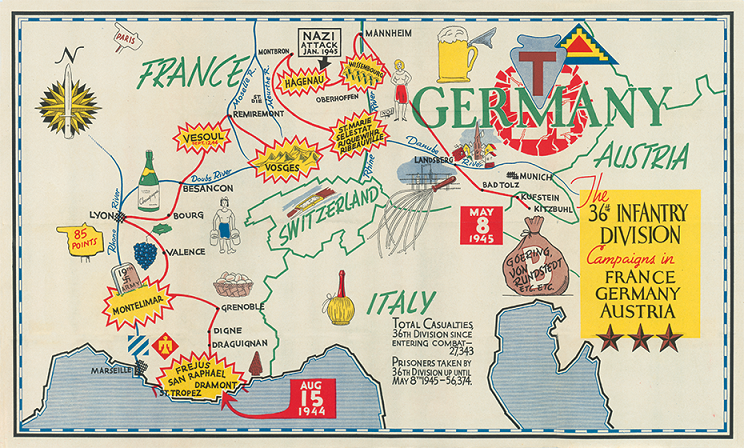 |
|
DIVISION CHRONICLEThe 36th Infantry Division landed in North Africa, 13 April 1943, and trained at Arzew and Rabat. It first saw action, 9 September 1943, when it landed at Paestum on the Gulf of Salerno. The waiting enemy launched counterattacks, but the 36th advanced slowly, securing the area from Agropoli to Altavilla. After a brief rest the 36th returned to combat, 15 November. It captured Mount Maggiore, Mount Lungo, and the village of San Pietro despite strong enemy positions and severe winter weather. This grueling campaign was marked by futile attempts to establish a secure bridgehead across the Rapido River, 1 January to 8 February 1944. After assisting the 34th Division in the attack on Cassino and fighting defensively along the Rapido River, the 36th withdrew, 12 March 1944, for rest and rehabilitation. On 25 May, the Division landed at Anzio, drove north to capture Velletri, 1 June, and entered Rome on the 5th. Pushing up from Rome, the 36th encountered sharp resistance at Magliano, but reached Piombino, 26 June, before moving back to Paestum for rest and rehabilitation. On 15 August, the Division made another assault landing against light opposition in the RaphaelFrejus area of Southern France. A lightning dash opened the Rhone River Valley. Montelimar fell, 28 August, and large Nazi units were trapped. The 36th advanced to the Moselle River at Remiremont and the foothills of the Vosges. In a grinding offensive, the Division crossed the Meurthe River, breached the Ste. Marie Pass and burst into the Alsatian Plains. The enemy counterattacked, 13 December, and the 36th held in the Colmar Pocket. On the 20th the Division resumed the attack, advancing northward along the Rhine River to Mannheim meeting heavy resistance at Haguenau, Oberhofen, and Wissembourg. The 36th moved to the Danube, 22 April 1945, and attacked the "National Redoubt" at Kunzelsau on the 30th in its final action. |
CHRONIQUE DE DIVISIONThe 36th Infantry Division landed in North Africa, 13 April 1943, and trained at Arzew and Rabat. It first saw action, 9 September 1943, when it landed at Paestum on the Gulf of Salerno. The waiting enemy launched counterattacks, but the 36th advanced slowly, securing the area from Agropoli to Altavilla. After a brief rest the 36th returned to combat, 15 November. It captured Mount Maggiore, Mount Lungo, and the village of San Pietro despite strong enemy positions and severe winter weather. This grueling campaign was marked by futile attempts to establish a secure bridgehead across the Rapido River, 1 January to 8 February 1944. After assisting the 34th Division in the attack on Cassino and fighting defensively along the Rapido River, the 36th withdrew, 12 March 1944 , for rest and rehabilitation. On 25 May, the Division landed at Anzio, drove north to capture Velletri, 1 June, and entered Rome on the 5th. Pushing up from Rome, the 36th encountered sharp resistance at Magliano, but reached Piombino, 26 June, before moving back to Paestum for rest and rehabilitation. On 15 August, the Division made another assault landing against light opposition in the RaphaelFrejus area of Southern France. A lightning dash opened the Rhone River Valley. Montelimar fell, 28 August, and large Nazi units were trapped. The 36th advanced to the Moselle River at Remiremont and the foothills of the Vosges. In a grinding offensive, the Division crossed the Meurthe River, breached the Ste. Marie Pass and burst into the Alsatian Plains. The enemy counterattacked, 13 December, and the 36th held in the Colmar Pocket. On the 20th the Division resumed the attack, advancing northward along the Rhine River to Mannheim meeting heavy resistance at Haguenau, Oberhofen, and Wissembourg. The 36th moved to the Danube, 22 April 1945, and attacked the "National Redoubt" at Kunzelsau on the 30th in its final action.
|
| SOURCE INFORMATION & PHOTO | Armydivs.squarespace.com |
|---|
| SOURCE INFORMATION & SOURCE PHOTO | Victor Daniel - Findagrave.com - Aad.archives.gov - Abmc.gov - Fold3 |
|---|---|
| PROGRAMMEURS | Eric, Henri, Garrett, Clive, Frédéric & Renaud |




















